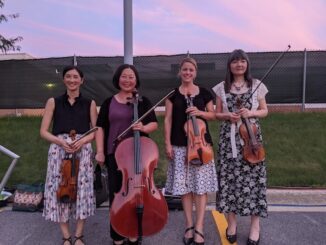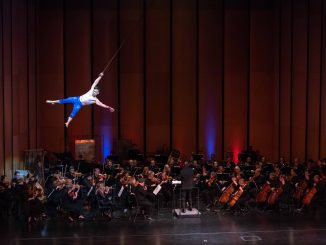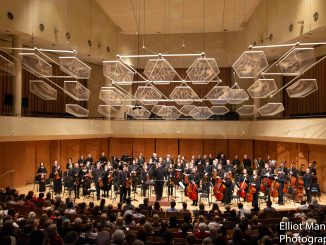
On October 15, 2017, the Chicago Philharmonic opened its 2017-2018 season, “Glorious Earth” with “Body and Soul”, at Pick-Staiger Hall, 50 Arts Circle Drive, Evanston. The program of works by Orff, Theofandis and Stravinsky, was conducted by Maestro Scott Speck and featured the Apollo Chorus of Chicago and the Evanston Children’s Choir. Also appearing were Soprano Martha Guth, known for her “intuitive sensitivity, and thrilling top range”; Baritone Hugh Russell, lauded for his beautiful voice, energy and charisma; and Tenor Justin Berkowitz, praised for his exciting and dramatic performances. As always, Speck introduced each piece on the program with an intriguing description of the work to be performed. He advised that the theme of the concert was “the relationship between spiritual and carnal Love”, and noted that all 3 works “look back at ancient texts, songs and legends”.
For the first selection, the audience heard Christopher Theofandis’ “Rainbow Body”, 2000. This otherworldly and intense piece was composed in recognition of the divine energy of the enlightened human, based on the musical chanting motifs of medieval mystic and visionary Hildegard von Bingen as well as the Tibetan Buddhist philosophy of “The Rainbow Body”, a belief that after death the body of a mystic is absorbed as light.

The piece begins almost unobtrusively, becomes eerie, with a distinctly “holy” feel, returning to the primary melody with a grace and lyrical loveliness after episodes of calm and peace. Speck had advised the audience that, unlike any other composition he knew, “Rainbow Body” captured an effect as of notes sustained long after they should fade- and indeed, it was so. A substantial piece, about 13 minutes long, it almost shimmers to a “thundering” and fierce climax.
The first half of the concert continued with the wondrous and unmistakable music of Igor Stravinsky’s “Firebird Suite,” 1910, which takes it’s name from the Russian legend of a magical bird who brings to those who try to own it either a blessing or a curse. This was the 27-year old composer’s first large-scale work for orchestra, and combines Russian folk melodies with influences of masters such as Scriabin and Rimsky-Korsakov, to whom the ballet music was dedicated.
Performed here with a fine attention to detail under the firm baton of Speck, it is clear that this was a piece of music intended for the theater. One is immersed in a cumulative dramatic tension, rhythmically intense. The Firebird itself is “painted” with “radiant trills”, the woodwinds always imaginative and invoking of magic.

The 2nd half of the program consisted of Carl Orff’s beloved “Carmina Burana”, 1935-36, inspired by a collection of medieval poems depicting the earthly experiences of fortune and fate. This is a work of art in 5 sections, based on the idea of the “Wheel of Fortune”, which spins from joy to sorrow, from hope to grief. However, the largest portion of “Carmina Burana” is contained in 3 sections: “Springtime in the Meadow” with poems about pastoral simplicity, man’s encounter with nature and how the seasons bring on love; “Wine in the Tavern”, in which the rowdy atmosphere breaks out with drinking songs and hymns to gambling and debauchery; and “The Court of Love”, the final section which describes the passions of men and women with the theme that natural sexual feelings should be expressed freely.
The work opens with the unforgettable “Oh Fortuna”, building relentlessly. The stage was set as follows: the Chicago Philharmonic playing furiously in formal black on the Pick-Staiger stage, led by Maestro Speck with controlled verve. Behind and above the Orchestra, on the balcony, massed the renowned Apollo Chorus, the oldest musical organization in Chicago, getting to their feet for the chanting mesmerizing vocals. On the balcony, at audience right, the Evanston Children’s Choir, sweetly intoning. In front of the Philharmonic, sometimes seated on chairs, sometimes standing, Hugh Russell joined by Martha Guth, Baritone and Soprano. Audience left, on the balcony, Tenor Justin Berkowitz enters, sings, and departs. The virtuosic soloists, all 3 of whom have a celebrated history performing this towering choral masterpiece, provided exemplary sound and spectacular comedic acting. Finally, unobtrusively prowling the house, as if on an invisible catwalk, the black-clad photographer, Elliot Mandel, who captured the images in this article.
Thus, Orff’s concept of “Theatrum Mundi”, in which music, movement and speech were inseparable, was in fact realized here, (although without dancing or visual art). The performance, as a cantata, influenced as it was by late Renaissance and early Baroque music was conducted with a tight rhythmic base by Speck, no easy task with the metric variations. The fully harmonized conclusion contains the return of “Oh Fortuna”, as the cycle of life in this sacred and profane ritual comes fully round. Throughout the work, the melodies produced by the instruments and the voices rose together and in tandem, technically demanding for the orchestra, vocal groups and soloists; a thrilling presentation that justified its popularity and renown.

For information and tickets to all the great performances by the Chicago Philharmonic, go to www.chicagophilharmonic.org
All photos by Elliot Mandel




Be the first to comment